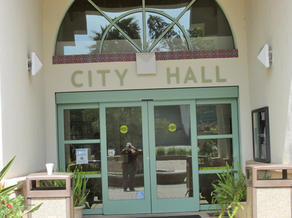The Avalon City Council on July 2 introduced an ordinance that amended the city code for curb markings. The council is expected to adopt the ordinance at the next council meeting, according to the staff report.
The council also declared that the Municipal Code amendment is exempt from the California Environmental Quality Act.
The vote was 4 to 1. Councilmember Mary Schickling cast the lone no vote. Schickling saw no necessity for the change. Fire Chief Michael Alegria and CIP Director Bob Greenlaw argued in favor of the new rules. (Time and space don’t allow a transcript of the entire discussion, so the following are highlights from the discussion.)
“As currently established, yellow and white curbs become unrestricted from 6 p.m. to 7 a.m. daily. The transition of the zones from restricted to unrestricted has, at times, created confusion for users,” Management Analyst Devin Hart and CIP Director Bob Greenlaw.
“There’s no loading and unloading taking place between 6 p.m. and 7 a.m.,” Schickling said.
Greenlaw told the council that they were trying to make a system that was understandable.
According to Fire Chief Michael Alegria, said the Fire Department needed to keep the fire lanes open.
“We need to set some rules,” Alegria said.
“We need something in writing that will back us,” Alegria said.
Councilmember Yesenia De La Rosa said would be more comfortable if there was clear enforcement.
Schickling questioned who would enforce the ordinance.
City Manager David Maistros said the Fire Department would enforce the ordinance.
Greenlaw argued that they were trying to make a system that was understandable by users and code enforcement.
Schickling proposed increasing the fines instead.
De La Rosa suggested taking a week or two to inform the public.
According to Maistros, staff was planning a 30-day warning period.
According to City Attorney Scott Campbell, if the ordinance was adopted, there would a 30-day period before the law goes into effect. The city would give warnings during that time.
Maistros: “Our goal is to change behavior, not rack up tickets.”
During the discussion, Councilmember Michael Ponce argued that they were giving code enforcement the tools they needed. According to Ponce, if this doesn’t work, the council can rescind the ordinance. But the council needed to provide staff with the tools.
According to Maistros, staff had been looking at the issue since he came to Avalon.
Ponce moved approval. Mayor Anni Marshall seconded.
Background
“City Staff have begun the process of reviewing the established loading and unloading zones for passengers and commercial goods,” according to the staff report by Management Analyst Devin Hart and CIP Director Bob Greenlaw.
“Per the authority established in Section 4-4.1101 of the Avalon Municipal Code (AMC), the City Manager, acting as the Traffic Engineer, may determine commercial loading zones and passengers zones at any place in the ‘business district’ and elsewhere in Avalon in front of any location used for the purpose of public assembly,” Hart and Greenlaw wrote.
“The AMC further defines the color of curb paint used to designate each type of zone as well as the timeframe that parking limitations are enforceable. As currently established, yellow and white curbs become unrestricted from 6 p.m. to 7 a.m. daily. The transition of the zones from restricted to unrestricted has, at times, created confusion for users,” Hart and Greenlaw wrote.
“To eliminate confusion, City Staff propose amending the ordinance to extend the parking limitations in designated commercial and passenger loading/unloading zones (white and yellow curbs) to 24 hours. Additionally, the proposed changes eliminate exceptions to certain regulations that exempted freight carriers from various restrictions. Such restrictions would apply to all vehicles,” Hart and Greenlaw wrote.
“City Staff believe the change in the AMC will allow for more consistent enforcement and less congestion in the designated unloading/loading areas,” Hart and Greenlaw wrote.
“As adoption of the ordinance will not result in a direct or reasonably foreseeable indirect physical change to the environment and because the adoption of the ordinance will no cause a change in any of the physical conditions within the area effected by the ordinance, the adoption of the ordinance is not subject to CEQA [California Environmental Quality Act] ,” Hart and Greenlaw wrote.











